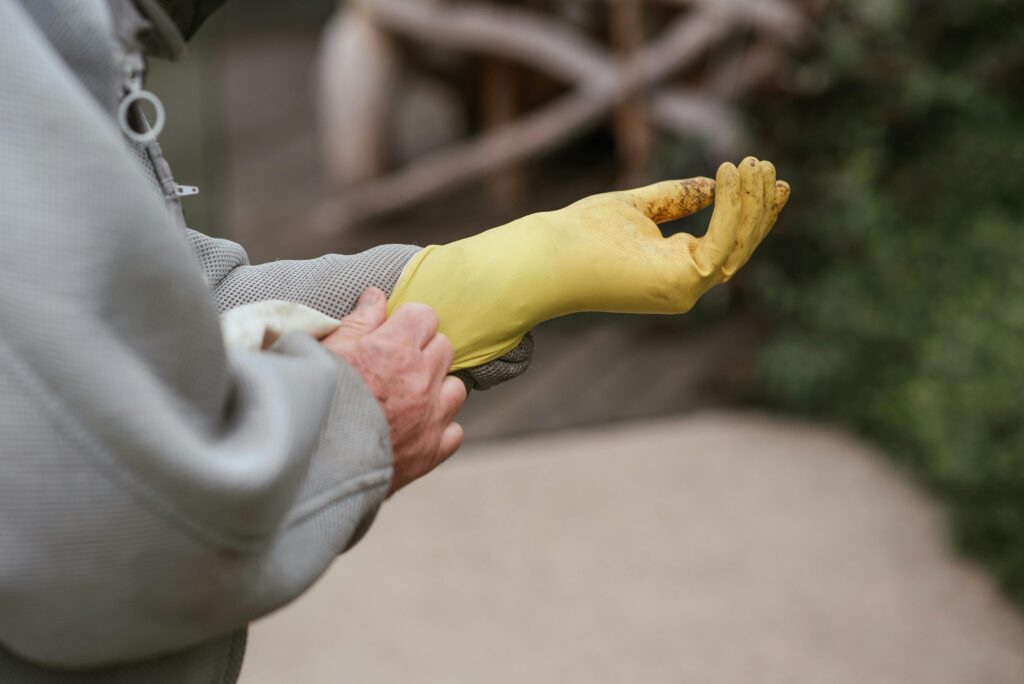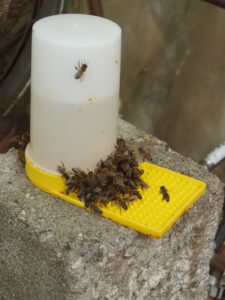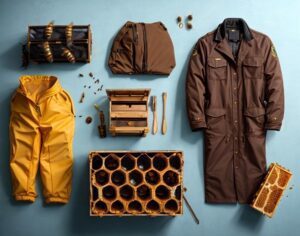Beekeeping suits are an essential part of any beekeeper’s toolkit, offering crucial protection and peace of mind while working with bees. This article delves into everything you need to know about beekeeping suits, from their importance to the features to look for when choosing one. We’ll explore the different types of suits available, including full-body suits, ventilated suits, and jacket-and-veil combos, to help you make an informed decision based on your specific needs and climate conditions.

Table of Contents
Overview
We’ll also discuss the key components of a beekeeping suit, such as the material, ventilation, and closures, and provide tips on how to ensure a proper fit for maximum comfort and safety. Additionally, we’ll cover the best practices for wearing, maintaining, and cleaning your suit to extend its lifespan and effectiveness.
Through real-life experiences and testimonials, we’ll highlight the practical benefits of wearing a beekeeping suit, addressing common myths and misconceptions. Finally, we’ll touch on the latest innovations in beekeeping suit design and offer recommendations on where to buy high-quality suits and accessories. Whether you’re a beginner or an experienced beekeeper, this comprehensive guide will equip you with the knowledge to protect yourself and enjoy a successful beekeeping experience.
Importance
Beekeeping suits are vital for the safety and confidence of beekeepers. They provide essential protection against bee stings, allowing beekeepers to work comfortably and efficiently. By minimizing the risk of stings, suits help prevent allergic reactions and reduce anxiety, making it easier to focus on hive management tasks. Moreover, protective suits prevent contamination of the hive by external pollutants, ensuring the health and productivity of the bee colony. Investing in a high-quality beekeeping suit is crucial for a safe and successful beekeeping experience.
Types of Beekeeping Suits
Full-Body Suits
Description
Full-body beekeeping suits are designed to provide comprehensive protection from head to toe, covering the entire body with a single piece of clothing. They typically feature an attached veil or hood to protect the head and face, as well as elastic bands at the wrists and ankles to prevent bees from entering the suit. These suits are often made from durable materials such as cotton or polyester and may include mesh panels for ventilation to keep the beekeeper cool.
Advantages
- Maximum Protection: Full-body suits offer the highest level of protection, covering all areas where bees might sting, including the head, torso, arms, and legs.
- Integrated Design: With an attached veil or hood, there are fewer gaps where bees could potentially enter, providing seamless protection.
- Comfort and Ease: These suits are designed for comfort and ease of use, with zippers and elastic bands ensuring a secure fit while allowing for easy on and off.
- Durability: Made from high-quality, durable materials, full-body suits can withstand the wear and tear of regular use, making them a long-lasting investment.
- Versatility: Suitable for various beekeeping activities, from hive inspections to honey harvesting, providing consistent protection across different tasks.
Use Cases

- Hive Inspections: During routine hive inspections, full-body suits protect beekeepers from potentially aggressive bees, allowing them to focus on assessing the health and productivity of the hive.
- Honey Harvesting: Harvesting honey can provoke bees, making full-body protection essential to prevent stings and ensure a smooth process.
- Swarm Management: Managing swarms, which can be more defensive, requires the enhanced protection that full-body suits offer.
- Pest and Disease Control: When applying treatments or conducting thorough inspections for pests and diseases, full-body suits provide a safeguard against defensive bee behavior. See 8 Common Beehive Pests and Effective Prevention Tips for Beekeepers for more information.
- Training and Education: For beginners or during educational demonstrations, full-body suits offer a confidence boost by minimizing the risk of stings, making the learning experience safer and more comfortable.
Full-body beekeeping suits are an indispensable part of a beekeeper’s gear, offering unparalleled protection and peace of mind during various beekeeping activities. Their comprehensive design ensures that beekeepers can work efficiently and safely, regardless of the task at hand.
Jacket and Veil Combos
Description
Jacket and veil combos are a popular choice among beekeepers who prefer a more flexible and lightweight option compared to full-body suits. These combos typically consist of a beekeeping jacket that covers the upper body and arms, paired with a detachable veil or hood to protect the head and face. They are often made from lightweight materials like cotton or synthetic fabrics, with mesh panels for ventilation to keep the beekeeper cool and comfortable during warm weather conditions.
Advantages
- Flexibility and Mobility: Jacket and veil combos offer greater freedom of movement compared to full-body suits, making them ideal for tasks that require agility and dexterity.
- Ease of Use: They are easier to put on and take off quickly, allowing for faster transitions between beekeeping activities.
- Comfort in Warm Weather: Lightweight materials and ventilation provide better airflow, keeping the beekeeper cool in hot climates.
- Cost-Effectiveness: Generally more affordable than full-body suits, making them a budget-friendly option for beekeepers.
- Versatility: Suitable for a wide range of beekeeping tasks, from routine inspections to light harvesting and maintenance.
Use Cases
- Routine Hive Inspections: Jacket and veil combos provide sufficient protection for routine inspections where bees are typically calm and less aggressive.
- Harvesting Honey: Ideal for harvesting honey when bees are generally less defensive, minimizing the need for full-body protection.
- Educational Purposes: Suitable for demonstrations and beginner beekeeping classes, offering adequate protection while allowing clear visibility of beekeeping techniques.
- Quick Tasks: When performing quick tasks around the hive, such as adding or removing frames or checking feeders, a jacket and veil combo offers convenient and effective protection.
When to Use a Jacket Instead of a Full Suit
- Warmer Climates: In hot weather conditions, a jacket and veil combo provides sufficient protection while allowing better ventilation and comfort.
- Less Aggressive Bees: During times when bees are less likely to be defensive, such as during honey flows or when colonies are calm, a jacket may be sufficient to protect against incidental stings.
- Quick Inspections: For brief hive inspections or tasks that do not involve extensive interaction with bees, a jacket and veil combo offers practical protection without the bulk of a full-body suit.
Jacket and veil combos offer a balanced combination of protection, comfort, and affordability, making them a popular choice among beekeepers for various beekeeping activities. Their versatility and ease of use ensure that beekeepers can work efficiently while maintaining adequate safety from bee stings.
Ventilated Suits
Description
Ventilated beekeeping suits are specifically designed to provide maximum protection while offering enhanced airflow and comfort, particularly in hot climates. These suits typically feature breathable mesh panels strategically placed in areas such as the torso, arms, and legs. They may also include ventilated veils or hoods to ensure adequate airflow around the head and face while minimizing the risk of bee stings. Ventilated suits are often made from lightweight and durable materials like polyester or a cotton-polyester blend to optimize comfort and protection.
Advantages
- Improved Airflow: Mesh panels and breathable fabrics allow air to circulate freely, keeping the beekeeper cool and comfortable during hot weather conditions.
- Reduced Heat Stress: Enhanced ventilation helps prevent overheating and reduces the risk of heat-related discomfort or exhaustion.
- Moisture Management: Ventilated suits effectively wick away sweat and moisture, enhancing comfort and preventing chafing.
- Lightweight Design: Despite their protective features, ventilated suits are lightweight and less bulky than traditional suits, providing greater mobility and agility.
- Versatility: Suitable for various beekeeping tasks, from hive inspections to honey harvesting, while maintaining optimal comfort and protection.
Use Cases
- Hot Weather Beekeeping: Ideal for beekeepers operating in warm or tropical climates where temperatures can be high year-round.
- Intensive Beekeeping Activities: During periods of active hive management, such as queen rearing, swarm management, or pollen and nectar collection, ventilated suits offer essential protection without compromising comfort.
- Long-duration Tasks: Suitable for extended periods of beekeeping work, such as during large-scale honey extraction or hive manipulations that require prolonged exposure to bees.
- Educational Settings: Ventilated suits are excellent for educational purposes, providing both safety and comfort during demonstrations and training sessions.
Benefits of Ventilated Suits for Hot Climates
Ventilated beekeeping suits offer significant benefits for beekeepers operating in hot climates:
- Heat Regulation: Mesh panels and breathable materials facilitate airflow, preventing heat buildup and allowing the beekeeper to work comfortably in high temperatures.
- Reduced Heat Stress: By keeping the beekeeper cool and dry, ventilated suits minimize the risk of heat-related illnesses, such as heat exhaustion or heat stroke.
- Enhanced Comfort: Lightweight construction and moisture-wicking properties ensure that beekeepers remain comfortable and focused on their tasks without feeling weighed down or overheated.
- Extended Wearability: The ability to maintain comfort over extended periods enables beekeepers to manage hives efficiently throughout the day, maximizing productivity and safety.
Ventilated suits are a practical choice for beekeepers seeking optimal protection and comfort in challenging climatic conditions, ensuring a safe and enjoyable beekeeping experience year-round.
Child-Sized Suits
Description
Smaller beekeeping suits are specially designed to provide young beekeepers with appropriate protection while engaging in beekeeping activities. These suits are scaled down in size to fit children comfortably, offering similar features to adult suits such as full-body coverage, protective veils or hoods, and durable materials like cotton or polyester. They often include adjustable closures and elastic bands to ensure a secure fit and prevent bees from entering the suit. Smaller suits may also come in bright colors or patterns to appeal to younger beekeepers and make them feel more comfortable and confident during their beekeeping endeavors.
Advantages
- Safety: Smaller suits provide essential protection against bee stings, ensuring the safety of young beekeepers while they learn and participate in beekeeping activities.
- Comfort: Designed with lightweight and breathable materials, these suits offer comfort and ease of movement, allowing children to enjoy beekeeping without feeling restricted.
- Education: By wearing suits similar to those used by adults, young beekeepers can learn proper beekeeping practices and safety measures from an early age.
- Empowerment: Wearing a suit tailored for their size helps children feel empowered and confident in handling bees and participating in hive inspections and other activities.
- Family Bonding: Smaller suits encourage family involvement in beekeeping activities, fostering bonding and shared learning experiences between parents and children.
Use Cases
- Educational Programs: Ideal for beekeeping clubs, schools, or educational workshops aimed at introducing children to the world of beekeeping in a safe and engaging manner.
- Family Beekeeping: Enables children to actively participate alongside their parents or guardians in family beekeeping projects, promoting hands-on learning and responsibility.
- Youth Organizations: Suitable for youth organizations such as scouting groups or 4-H clubs interested in incorporating beekeeping into their educational curriculum.
- Community Events: Used during community outreach events or demonstrations to educate young participants about bees, pollination, and the importance of bee conservation.
Options for Young Beekeepers
When selecting child-sized beekeeping suits, consider the following options:
- Adjustable Features: Look for suits with adjustable closures at the wrists, ankles, and hood to ensure a snug and secure fit.
- Bright Colors: Choose suits in bright colors or fun patterns that appeal to children and enhance visibility during beekeeping activities.
- Durable Materials: Opt for suits made from durable fabrics that offer protection against bee stings while remaining lightweight and comfortable.
- Ease of Use: Prioritize suits that are easy for children to put on and take off independently, fostering a sense of autonomy and confidence.
Child-sized beekeeping suits play a vital role in introducing young individuals to beekeeping in a safe and enjoyable manner, fostering a lifelong appreciation for bees and their role in the environment.
Additional Resources
Advanced Techniques in Apiculture: 10 Pro Tips for Beekeepers
10 Tips for Choosing the Best Gloves for Beekeepers

USDA PROGRAMS AND RESOURCES TO SUPPORT BEEKEEPERS
Conclusion
In conclusion, selecting the right beekeeping suit is crucial for ensuring safety and comfort while tending to your hive. Each type of suit offers unique features that cater to different preferences and needs, from full protection to lightweight options for warmer climates. Whether you opt for a traditional full-body suit, a ventilated jacket, a fencing veil setup, or a lightweight option, prioritize fit, quality materials, and durability. By choosing the suit that best suits your beekeeping environment and practices, you’ll enhance your experience and enjoyment while safeguarding yourself against stings. Happy beekeeping!



